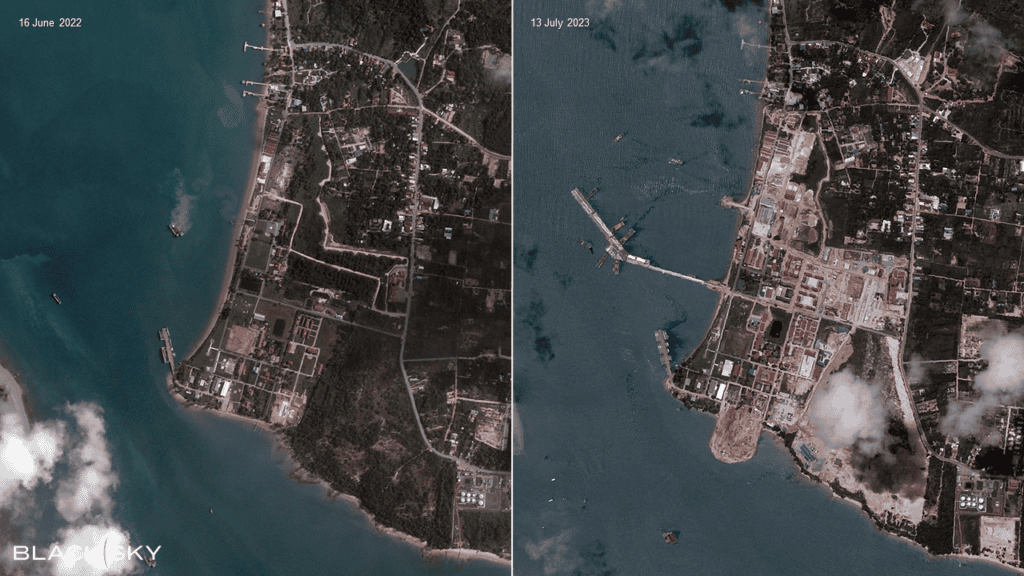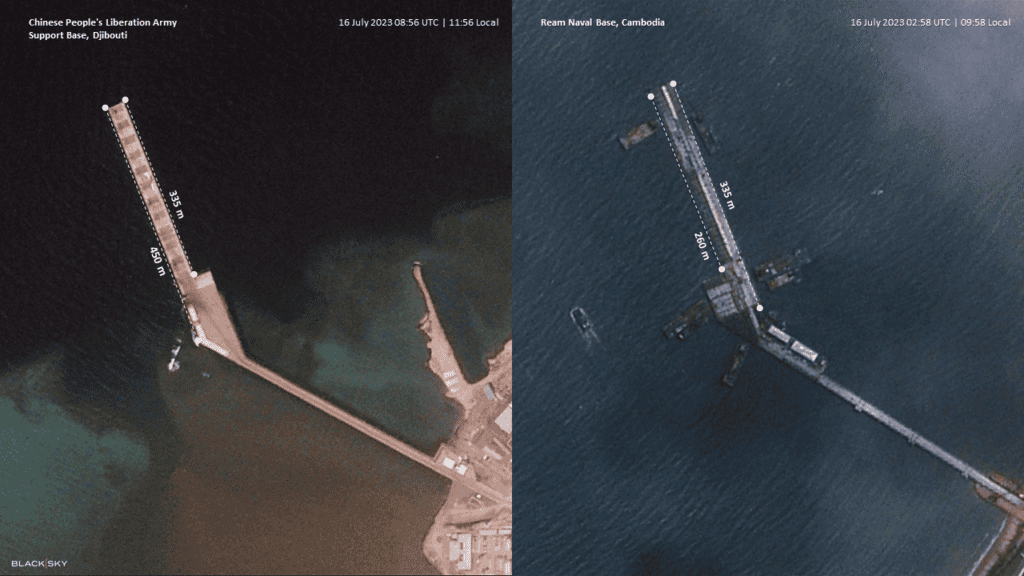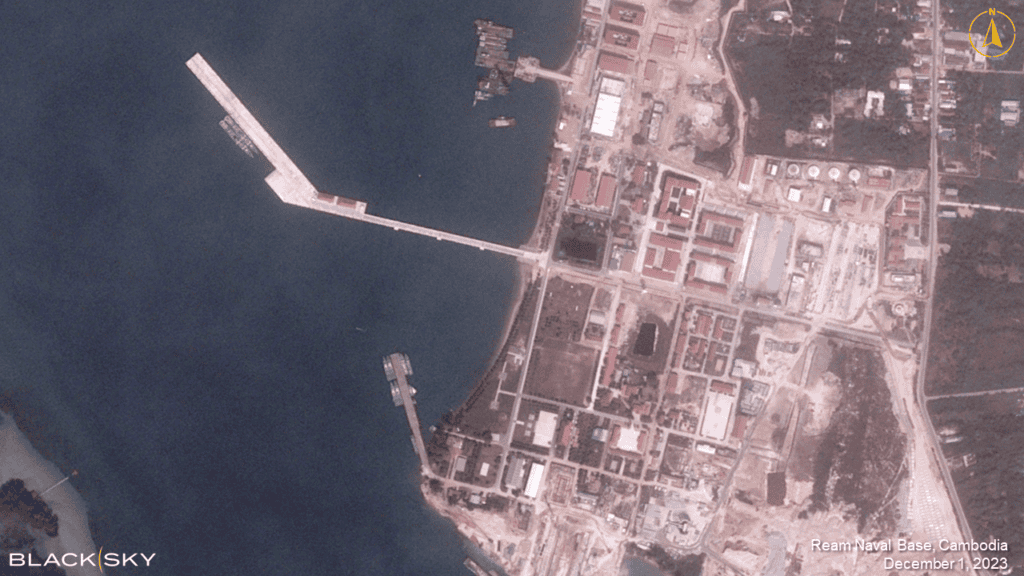A secret agreement brought to light by the Wall Street Journal in 2019 granting China access to the Cambodian naval base at Ream prompted alarm and swift denials from both governments.
For years, China’s emerging global military ambitions and assertive posture in the Indo-Pacific have sparked concern over regional security and stability among the U.S. and its allies. With an uptick in Pacific-region tensions, the need for accurate and timely situational awareness has never been greater.
BlackSky gave the world its first look at China’s militarization of the Ream port and more recently, revealed yet another tinder box move: permanently basing naval warships at the base, located on Cambodia’s southern tip near the South China Sea.
Predictive power
BlackSky dynamically monitors the most important and strategic locations on Earth, Ream included. Anticipating the buildup of China’s second major overseas military installation could only happen thanks to the BlackSky Spectra® platform. This platform was designed with automation as a key feature and delivers imagery and analytics up to 15 times per day, with a typical tasking to delivery timeline of 90 minutes or less.
The revelations at Ream demonstrate how commercial, space-based monitoring can deliver actionable intelligence at machine speed and scale. BlackSky’s unique ability to deliver low-latency imagery and analytics empowers end users with unparalleled foresight: predictive power for a true strategic advantage.
A two-year development
Beginning in June 2022, BlackSky tracked a rapid increase in the pace and scale of construction at Ream. Expansive tree clearing gave way to evidence of new building and pier construction. As the Spectra® platform ramped up monitoring over this AOI, a new, more startling development came into focus.
With data spanning August 2021 to July 2023, BlackSky was the first to reveal and accurately identify the preliminary construction of what became an angled, deepwater military pier.
This video shows the progression of development at Ream Naval Base from June 2022 to May 2024.

Imagery from June 2022 (on left) and July 2023 (on right) show the newly created deepwater angled pier at Ream.
Measuring more than 360 meters in length once complete, the pier is large enough to support any Chinese naval ship, including the new 300-meter-long Type 003 Fujian aircraft carrier, said Craig Singleton, a senior China fellow at the Foundation for Defense of Democracies think tank. More importantly, this military pier was nearly identical to another one secretly built by China in Djibouti, Beijing’s first overseas base on the Horn of Africa.

On left, image of China’s People’s Liberation Army‘s presence in Djibouti on the Horn of Africa. On right, a nearly identical pier at Ream.
In 2016, according to Singleton, Chinese and Djiboutian officials denied reports that Beijing was trying to establish a permanent military presence. And yet, less than a year later, the PLA sent ships from its South Sea Fleet to Djibouti and conducted six weeks of live-fire exercises.
China has now repeated that pattern in Cambodia.
In December 2023, additional imagery exposed the first time two combat-oriented, Type 056 Chinese Corvettes deployed to Ream and mostly remained there ever since. Analysis of automated vessel detections revealed the operating tempo of the ships, which always traveled in pairs and participated in the May joint Chinese-Cambodian Golden Dragon military exercises. Recent reports indicate China may be handing over the expanded facilities at Ream to the Cambodian military and gifting them two corvettes, continuing to obscure the reality of Beijing’s operations at Ream.

The upper-left portion of this December 2023 image shows the two Corvettes docked at the new deepwater, angled Pier at Ream. BlackSky’s dynamic monitoring allows automated ship detections, which shows the Corvettes always travel in pairs.
China’s quest for global reach
China has the world’s largest naval fleet with more than 370 warships, according to the U.S. Department of Defense. The country seeks to operate beyond its shores and sustain global reach, which requires overseas ports.
Until now, the only foreign port was Djibouti. The Ream base now makes two.
Experts like Singleton have long predicted China’s ambitions to become a “blue-water navy” — one that can deploy task forces on the ocean and support them from distant existing bases (i.e., Ream and Djibouti). The Ream base provides the PLA Navy closer access to the southern South China Sea and bolsters new defense ties with Cambodia, a concern for Vietnam, according to Carl Schuster, a former director of operations at the US Pacific Command’s Joint Intelligence Center.
Are more bases on the horizon?
China’s intentions for Ream started out as a mystery before BlackSky capabilities exposed the activity. Does China have more overseas bases planned?
In early 2024, the U.S. intelligence community warned Congress that China is pursuing other naval bases, with its eyes set on places such as Burma, Cuba, Equatorial Guinea, Pakistan, Seychelles, Sri Lanka, Tanzania and the United Arab Emirates. Many of these locations are near brick-and-mortar U.S. military sites where the PLA would be well positioned to monitor and control vital maritime routes.
BlackSky enables organizations to monitor developments like these closely.
Keeping organizations one step ahead
We live in a dynamic world where situations on the ground can change at a moment’s notice. The ability to act quickly can save lives and protect national security.
The Ream naval base development demonstrates how low-latency, space-based intelligence helps organizations understand patterns of life, with automated detection.
BlackSky’s satellites follow the equator, enabling monitoring of areas where most human activity and commerce occurs. Organizations can automatically detect vessels or objects and track their movement. Plus, the power of AI automation allows customers to endlessly scale analyses.
It gives customers what they need to not only act fast, but first.
Ready to start a conversation about how your organization can harness the power of space-based intelligence for dynamic monitoring? You can contact us here. Be sure to subscribe to stay at the forefront of innovation in space-based intelligence.
